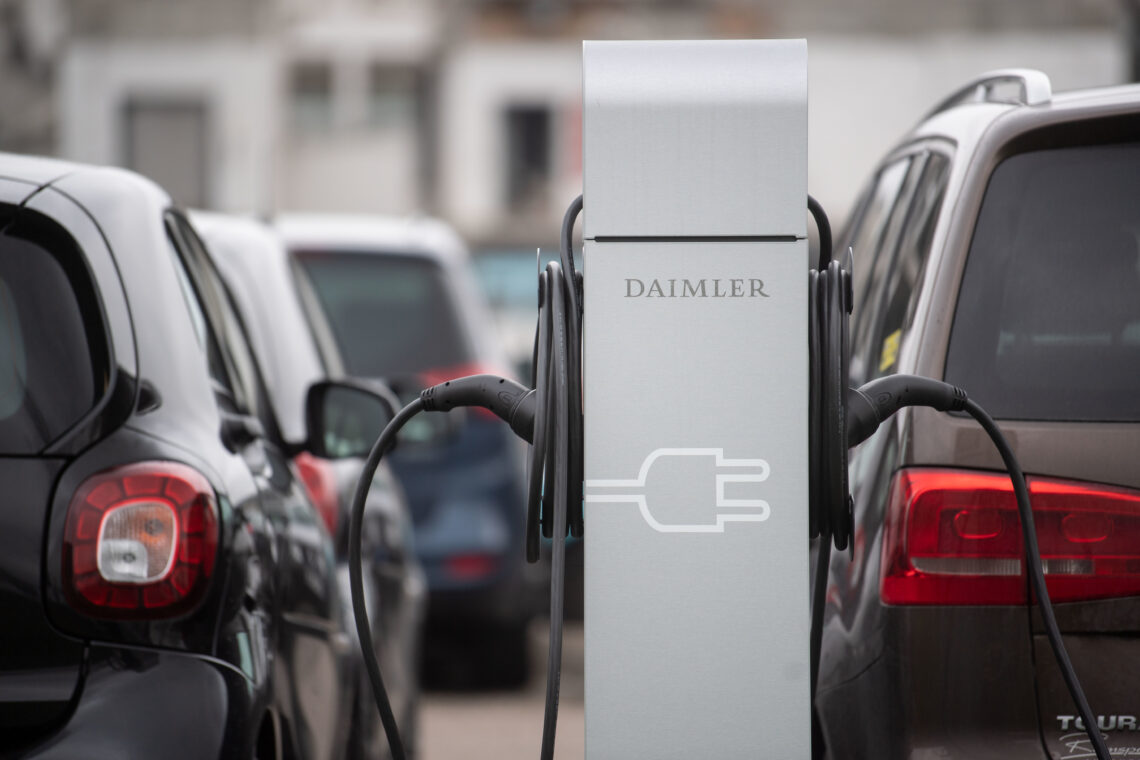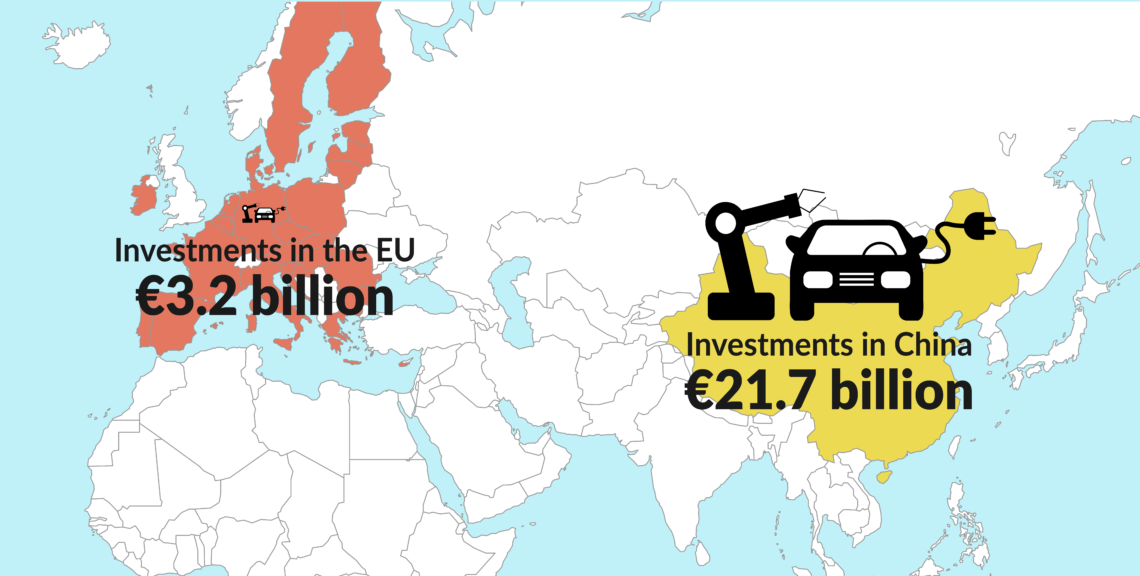EU-U.S. trade row spreads to automotive industry
Already burdened with tightening regulations and growing competition, the European automotive industry is now facing the threat of U.S. tariffs as the trade row between Washington and the EU escalates. A deal could materialize before the end of March 2020.

In a nutshell
- The Trump administration is considering imposing tariffs on EU car imports
- The European automotive industry is facing threats on several fronts
- European carmakers will need to catch up with their Chinese counterparts to stay competitive
Escalating trade tensions between two of the world’s largest economies will soon affect vehicle producers. Europe’s automotive industry is facing an unpredictable transatlantic tug-of-war that could lead to tariffs on European Union vehicles and vehicle components. The measures would not only come at a bad time for the industry, they could also destabilize European car manufacturers, creating significant financial implications for the EU.
Tariffs and trade deals
The dispute between Brussels and Washington is escalating and the automotive sector, one of Europe’s key economic industries, could soon face the consequences. The United States, the EU’s main trade partner, has given the bloc two options: collaborate or face financial retaliation.
The EU’s automotive industry provides jobs to almost 14 million people. The turnover generated by the automotive industry represents more than 7 percent of the union’s gross domestic product (GDP). However, the sector is mostly growing thanks to car exports, which generate an annual trade surplus of 84.4 billion euros. Any measures affecting the industry will seriously endanger Europe’s economy.
In May 2018, the U.S. Department of Commerce launched an investigation into imports of cars and car parts with reference to Section 232 of the U.S. Trade Expansion Act. In 2019, the investigation was summarized in a report allegedly concluding that vehicles and vehicle components imported from the EU were weakening the U.S. economy and posed a threat to U.S. national security.
The EU’s automotive industry provides jobs to almost 14 million people.
As a result, President Trump declared he would consider imposing 25 percent import tariffs on European cars. While the end of 2019 marked the deadline for implementing retaliatory measures under Section 232, the Trump administration is now eyeing Section 301 of the Trade Act, which would broaden the circumstances under which tariffs could be introduced.
In February 2020, National Economic Council Director Larry Kudlow, stated that U.S. tariffs on EU cars and car parts would be put on hold to reach a transatlantic trade deal – an outcome that was perhaps the true motive of the investigation into EU vehicle imports.
There have been many such transatlantic trade talks in the past. In May 2019, representatives of the EU and the U.S. discussed signing a transatlantic free trade agreement, but the talks were unproductive and continuously delayed. However, under the threat of imminent tariffs, the EU finds itself cornered and compelled to return to the negotiating table.
Automotive slowdown
The European automotive sector is already facing several challenges. After six consecutive years of growth, EU car sales are predicted to drop in 2020. German exports are especially affected. The Volkswagen Group, BMW and Daimler produced 4.66 million vehicles in Germany last year – their lowest output since 1996.
The industry is facing the repercussions of the Dieselgate scandal, in which several companies manipulated diesel emission tests. In 2019, the Volkswagen Group reported the scandal had cost over 33 billion dollars. In the first days of February 2020, German carmaker Daimler declared a 60-percent drop in 2019 earnings because of litigation costs stemming from the scandal, among other things. Daimler plans to fire more than 10,000 employees by the end of 2022 to mitigate its losses.
Producers like Volkswagen and Daimler will continue to struggle.
Despite German Chancellor Angela Merkel’s recent promises to introduce national measures preventing job losses due to the sector’s downturn, producers like Volkswagen and Daimler will continue to struggle. As of January 2020, the industry faces CO2-emission regulations from Brussels – a costly transition for manufacturers. Moreover, within the framework of the EU’s Green Deal and the upcoming proposal for a first EU-wide climate law in March 2020, the automotive industry will need to bear the costs of a rapid shift to carbon-neutral transport.
Chinese competition
While the European automotive sector is caught up in new regional regulations and faces the threat of U.S. tariffs, it is also under pressure because of its Chinese competitors.
If, in a limited transatlantic trade deal, the EU lowered its own tariffs on cars, it would de facto make Chinese vehicles more competitive. Furthermore, Europe is also falling behind China in the race for electric transportation – mostly due to a lack of crucial infrastructure despite billion-dollar investments.
Facts & figures

Not only is China subsidizing its industry and entering the EU market with lower-priced electric cars, it has managed to secure 21.7 billion euros to make electric vehicles in China from European carmakers thanks to favorable conditions such as monetary incentives and large-scale infrastructure deployment. In comparison, the EU has secured seven times less, a mere 3.2 billion euros. If the trend continues and Europeans mostly import electric vehicles from China, a quarter of jobs in the European automotive sector could be lost and offshored, which would inevitably affect the EU’s GDP.
Scenarios
In the short-term, it is likely that the Trump administration will continue to put pressure on the EU. U.S. trade representative Robert Lighthizer has postponed a tariff increase on European company Airbus until March 18; Europe may prove willing to make concessions before the deadline.
The EU could reluctantly agree to some of President Trump’s terms and accommodate a few of the administration’s requirements. U.S. exports of passenger cars to the EU face a 10 percent tariff. EU exports to the U.S. face a 2.5 percent tariff. Adjustments to this discrepancy could prove a small step forward, but it is unlikely to be enough to reach a consensus.
Former U.S. Ambassador to the EU Gordon Sondland has consistently urged the two parties to start with a clean slate to unblock the trade talks. He also proposed a reasonable inclusion of agricultural products in the trade agreement. However, after Mr. Sondland’s dismissal from the Trump administration, the EU faces a tougher negotiating stance, with hardball tactics to make agriculture a significant part of the trade deal.
President Trump and his team consider the agricultural sector a crucial tool to reduce U.S. deficits. In their eyes, the EU and its agricultural lobbying have kept the European market closed to U.S. farmers, while European agricultural goods have been exported across the Atlantic with ease. Europe has voiced environmental concerns as the main reasons for not wanting to open up its market to U.S. agricultural goods. Furthermore, French President Emmanuel Macron has stated that France will not support a trade deal with a country that is not part of the Paris Agreement on climate change.
With such a deadlock at hand, a comprehensive trade deal would be inconceivable. On January 27, 2020, President Trump announced his plans to increase tariffs on European steel and aluminum. Then, on February 14, 2020, the U.S. administration declared it would increase tariffs on European aircraft, further pressuring the EU in the protracted transatlantic aviation dispute. It is likely that Washington will apply similar measures to Europe’s automotive industry.
Should the U.S. introduce tariffs on EU cars and car parts, the EU would retaliate. On February 3, 2020, European Commissioner for Trade Phil Hogan stated that the EU’s vehicle exports do not pose a threat to U.S. national security. According to Mr. Hogan, the EU intends to not only contest any measure directed at its automotive industry, but respond in a proportionate manner.
The EU’s traditional modus operandi has been to bet on diplomacy rather than retaliation, and despite occasional countermeasures, the EU has often sought World Trade Organization (WTO) settlements and shown a clear preference for keeping disputes at bay. If it were to come to mutual tariff impositions, the EU will probably try to find settlement options through other means as well. A limited deal that cracks the door open for U.S. farmers on one hand but takes into account some climate considerations on the other would seem feasible.
But will U.S. tariffs and EU retaliations derail the European automotive sector in the meantime? If negotiations drag on, the demand for EU cars in the U.S. will decrease over time, noticeably affecting German car manufacturing and slowing the EU’s economic growth.
Europe is not the only party exposed to economic hardship because of automotive tariffs. Due to the deep integration of U.S. and European automotive supply chains, the Michigan-based Center for Automotive Research estimates that the U.S. automotive sector could lose billions of dollars and face a decline in employment. In light of the imminent U.S. presidential election, a trade deal would be in both parties’ interests.
There are also windows of opportunity when it comes to the challenge posed by Beijing. The Chinese government has significantly cut its subsidies for electric vehicles in 2019, and a further halt in subsidies is expected in 2021. France and Germany recently announced a 5-billion euro investment plan to establish two large battery production plants in the coming years. That initiative could return momentum to Europe and put a halt to the sector’s recent economic troubles.








